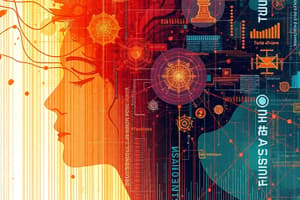Podcast
Questions and Answers
What does data literacy allow a person to do?
What does data literacy allow a person to do?
- Store data without analyzing
- Ignore data
- Only collect data
- Collect, read, analyze, and interpret data (correct)
Data is only found in electronic formats.
Data is only found in electronic formats.
False (B)
What is big data?
What is big data?
Big data refers to extremely large datasets that can be analyzed for insights and trends.
In simple terms, data refers to raw facts or __________ that are collected, stored, and analyzed.
In simple terms, data refers to raw facts or __________ that are collected, stored, and analyzed.
Match the following terms with their definitions:
Match the following terms with their definitions:
How do AI algorithms utilize data?
How do AI algorithms utilize data?
Data literacy is less important in today's data-driven world.
Data literacy is less important in today's data-driven world.
What is an example of how data is used in everyday life?
What is an example of how data is used in everyday life?
Flashcards are hidden until you start studying
Study Notes
Understanding AI and Data Literacy
- AI is integrated into daily activities such as emailing, shopping, movie searching, and navigation.
- AI algorithms utilize data to provide personalized recommendations based on user behavior and preferences.
Importance of Data Literacy
- Data literacy is crucial in today’s data-driven world, where understanding data influences decision-making.
- The upcoming unit will cover the basics of data literacy, including different data categories, to foster a data-centric culture.
Basics of Data
- Data exists in various forms, from social media likes to sports scores.
- Common data examples include personal information recorded on exam papers, which helps identify and assess student performance.
Data Literacy Defined
- Data literacy involves the ability to effectively collect, manage, analyze, and interpret data.
- It is akin to reading a narrative depicted by the data, forming a comprehensive understanding of its implications.
Key Definitions
- Data: Raw facts or statistics collected for specific purposes, akin to individual pieces of a puzzle forming a complete picture.
- Datasets: Collections of related data points, often used for analysis.
- Big Data: Large and complex datasets that traditional data processing software cannot manage efficiently.
Purpose of Data Literacy
- Enabling individuals to make informed decisions based on data analysis and interpretation.
- Encouraging effective communication of data insights across various fields.
Studying That Suits You
Use AI to generate personalized quizzes and flashcards to suit your learning preferences.




